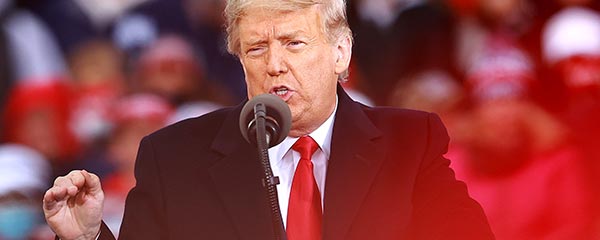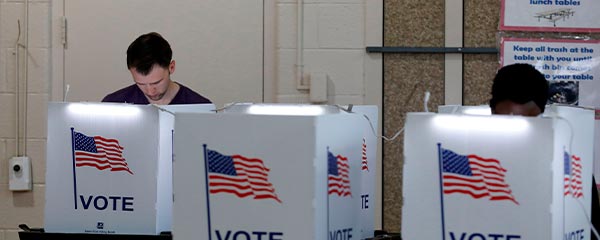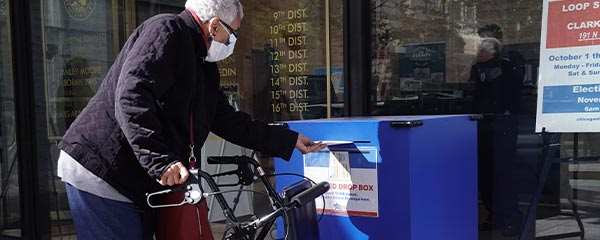Story Highlights
- 69% of voters more enthusiastic than in prior years; up from 50% in 2016
- 64% of voters afraid of what will happen if their candidate loses
- 77% of voters say stakes are higher this year than in previous elections
WASHINGTON, D.C. -- As the 2020 race for president draws to a close, U.S. voters are feeling both enthusiastic about voting and fearful of what the outcome will mean for the country if their candidate loses. Most also agree that the stakes are higher than in previous presidential elections.
Against this fraught backdrop, former Vice President Joe Biden enjoys a slightly better image with the American people than does President Donald Trump, earning a 49% favorable rating to Trump's 45%. Biden's favorability advantage widens to five percentage points among registered voters and to nine points among likely voters.
Meanwhile, the Republican Party roughly matches the Democratic Party in favorability from Americans as a whole and registered voters -- 44% and 45%, respectively. The GOP trails the Democratic Party in favorability by five points, 43% to 48%, among likely voters.
In the latest poll, conducted Oct. 16-27, 77% of Americans say they have given "quite a lot of thought" to the election for president, about average for the past six elections. However, in a sign that voter turnout may not be favorable to Trump, Democrats have a slight edge over Republicans on this measure. Eighty percent of Democrats and Democratic-leaning independents say they have given the election quite a lot of thought compared with 75% of Republicans and Republican-leaning independents. Still, given that this year's final preelection estimate was collected earlier than in prior election years, turnout may ultimately be higher.
This is the broad picture of voters' election mindset and orientation to the candidates from Gallup's final preelection poll of 2020. Read on for more details, including who has already voted and who plans to vote in person on Nov. 3.
Enthusiasm Running High, Especially Among Democrats
U.S. voters' enthusiasm about voting in the 2020 election remains high in the final days of the campaign, with 69% of registered voters saying they are "more enthusiastic than usual." This is significantly higher than the 50% who were enthusiastic at the end of the 2016 campaign but on par with the levels seen in 2004 and 2008.
| U.S. registered voters | Rep/Rep-leaning independents | Dem/Dem-leaning independents | |||||||||||||||||||||||||||||||||||||||||||||||||||||||||||||||||||||||||||||||||||||||||||||||||
|---|---|---|---|---|---|---|---|---|---|---|---|---|---|---|---|---|---|---|---|---|---|---|---|---|---|---|---|---|---|---|---|---|---|---|---|---|---|---|---|---|---|---|---|---|---|---|---|---|---|---|---|---|---|---|---|---|---|---|---|---|---|---|---|---|---|---|---|---|---|---|---|---|---|---|---|---|---|---|---|---|---|---|---|---|---|---|---|---|---|---|---|---|---|---|---|---|---|---|---|
| % | % | % | |||||||||||||||||||||||||||||||||||||||||||||||||||||||||||||||||||||||||||||||||||||||||||||||||
| 2020 | 69 | 66 | 75 | ||||||||||||||||||||||||||||||||||||||||||||||||||||||||||||||||||||||||||||||||||||||||||||||||
| 2016 | 50 | 53 | 50 | ||||||||||||||||||||||||||||||||||||||||||||||||||||||||||||||||||||||||||||||||||||||||||||||||
| 2012 | 64 | 73 | 61 | ||||||||||||||||||||||||||||||||||||||||||||||||||||||||||||||||||||||||||||||||||||||||||||||||
| 2008 | 68 | 61 | 76 | ||||||||||||||||||||||||||||||||||||||||||||||||||||||||||||||||||||||||||||||||||||||||||||||||
| 2004 | 67 | 68 | 70 | ||||||||||||||||||||||||||||||||||||||||||||||||||||||||||||||||||||||||||||||||||||||||||||||||
| 2000 | 38 | 45 | 35 | ||||||||||||||||||||||||||||||||||||||||||||||||||||||||||||||||||||||||||||||||||||||||||||||||
| GALLUP | |||||||||||||||||||||||||||||||||||||||||||||||||||||||||||||||||||||||||||||||||||||||||||||||||||
Democrats have a clear edge over Republicans on enthusiasm, with 75% and 66%, respectively, feeling more enthusiastic. While not quite as large as Democrats' 15-percentage-point enthusiasm advantage in 2008 when Barack Obama was running for the first time, the current nine-point spread contrasts with a near tie in 2016 and Republican advantages in 2012 and 2000.
In Gallup's September update, the parties had similar levels of enthusiasm, suggesting a slight erosion in GOP fervor compared with a month ago.
优蜜传媒analysis of this question has found that a party with significantly greater enthusiasm does not necessarily vote at a higher rate than the opposing party.
Both Parties Fear Outcome if Preferred Candidate Loses
Even as voters are feeling enthusiastic about voting, a record-high 64% strongly agree with the statement that they are "afraid of what will happen if my candidate for president does not win." While 优蜜传媒did not ask this question in 2016, the rate was stable near 55% from 2004 to 2012, and a much lower 35% in 1996.
Democrats and Democratic-leaning independents (66%) and Republicans and Republican-leaning independents (65%) are equally likely to fear the outcome if their preferred candidate loses. Republicans' fear is similar to their sentiment in 2012 when Obama faced Mitt Romney but higher than readings before then. Meanwhile, this is the first time Democrats' fear has topped 56% in the 优蜜传媒trend, although it may have been higher than that in 2016.
| U.S. registered voters | Rep/Rep-leaning independents | Dem/Dem-leaning independents | |||||||||||||||||||||||||||||||||||||||||||||||||||||||||||||||||||||||||||||||||||||||||||||||||
|---|---|---|---|---|---|---|---|---|---|---|---|---|---|---|---|---|---|---|---|---|---|---|---|---|---|---|---|---|---|---|---|---|---|---|---|---|---|---|---|---|---|---|---|---|---|---|---|---|---|---|---|---|---|---|---|---|---|---|---|---|---|---|---|---|---|---|---|---|---|---|---|---|---|---|---|---|---|---|---|---|---|---|---|---|---|---|---|---|---|---|---|---|---|---|---|---|---|---|---|
| % | % | % | |||||||||||||||||||||||||||||||||||||||||||||||||||||||||||||||||||||||||||||||||||||||||||||||||
| 2020 | 64 | 65 | 66 | ||||||||||||||||||||||||||||||||||||||||||||||||||||||||||||||||||||||||||||||||||||||||||||||||
| 2012 | 55 | 63 | 53 | ||||||||||||||||||||||||||||||||||||||||||||||||||||||||||||||||||||||||||||||||||||||||||||||||
| 2008 | 54 | 56 | 55 | ||||||||||||||||||||||||||||||||||||||||||||||||||||||||||||||||||||||||||||||||||||||||||||||||
| 2004 | 54 | 56 | 56 | ||||||||||||||||||||||||||||||||||||||||||||||||||||||||||||||||||||||||||||||||||||||||||||||||
| 1996 | 35 | 33 | 38 | ||||||||||||||||||||||||||||||||||||||||||||||||||||||||||||||||||||||||||||||||||||||||||||||||
| GALLUP | |||||||||||||||||||||||||||||||||||||||||||||||||||||||||||||||||||||||||||||||||||||||||||||||||||
Driving this election anxiety, 77% of voters, including roughly equal proportions of Republicans and (77%) and Democrats (79%), agree with the statement that the stakes in this year's election are higher than in previous years. This matches the level from 2008 but is higher than in other years when the question has been asked.
| U.S. registered voters | Rep/Rep-leaning independents | Dem/Dem-leaning independents | |||||||||||||||||||||||||||||||||||||||||||||||||||||||||||||||||||||||||||||||||||||||||||||||||
|---|---|---|---|---|---|---|---|---|---|---|---|---|---|---|---|---|---|---|---|---|---|---|---|---|---|---|---|---|---|---|---|---|---|---|---|---|---|---|---|---|---|---|---|---|---|---|---|---|---|---|---|---|---|---|---|---|---|---|---|---|---|---|---|---|---|---|---|---|---|---|---|---|---|---|---|---|---|---|---|---|---|---|---|---|---|---|---|---|---|---|---|---|---|---|---|---|---|---|---|
| % | % | % | |||||||||||||||||||||||||||||||||||||||||||||||||||||||||||||||||||||||||||||||||||||||||||||||||
| 2020 | 77 | 77 | 79 | ||||||||||||||||||||||||||||||||||||||||||||||||||||||||||||||||||||||||||||||||||||||||||||||||
| 2012 | 63 | 72 | 57 | ||||||||||||||||||||||||||||||||||||||||||||||||||||||||||||||||||||||||||||||||||||||||||||||||
| 2008 | 76 | 73 | 81 | ||||||||||||||||||||||||||||||||||||||||||||||||||||||||||||||||||||||||||||||||||||||||||||||||
| 2004 | 70 | 66 | 76 | ||||||||||||||||||||||||||||||||||||||||||||||||||||||||||||||||||||||||||||||||||||||||||||||||
| 1996 | 37 | 38 | 36 | ||||||||||||||||||||||||||||||||||||||||||||||||||||||||||||||||||||||||||||||||||||||||||||||||
| GALLUP | |||||||||||||||||||||||||||||||||||||||||||||||||||||||||||||||||||||||||||||||||||||||||||||||||||
Neither Candidate Cracks 50% Favorable Rating With American People
Neither Trump nor Biden are viewed favorably by a majority of Americans, although Biden is closer, with 49% holding a favorable and 48% an unfavorable opinion of him. Trump's favorable rating is now 45%, with 54% viewing him unfavorably.
优蜜传媒has measured opinions of presidential candidates using the binary favorable/unfavorable rating in all eight elections since 1992. In most election years, at least one of the two major-party candidates, if not both, were viewed favorably by a majority of Americans. In only two elections -- 2016 and 2020 -- both candidates failed to appeal to more than half of Americans, and 1992 just barely escaped this characterization as Bill Clinton was viewed favorably by 51% and George H. W. Bush by 43%.
Looking at likely voters, Biden's 52% favorability rating is much better than Hillary Clinton's 43% at the same point four years ago, and comparable to Obama's in 2012. Trump's 43% favorable rating among likely voters is slightly better than his 39% in 2016, but otherwise the lowest for any Republican presidential candidate in 优蜜传媒records since 1992.
| Republican candidate | U.S. adults | Likely voters | Democratic candidate | U.S. adults | Likely voters | ||||||||||||||||||||||||||||||||||||||||||||||||||||||||||||||||||||||||||||||||||||||||||||||
|---|---|---|---|---|---|---|---|---|---|---|---|---|---|---|---|---|---|---|---|---|---|---|---|---|---|---|---|---|---|---|---|---|---|---|---|---|---|---|---|---|---|---|---|---|---|---|---|---|---|---|---|---|---|---|---|---|---|---|---|---|---|---|---|---|---|---|---|---|---|---|---|---|---|---|---|---|---|---|---|---|---|---|---|---|---|---|---|---|---|---|---|---|---|---|---|---|---|---|---|
| % | % | % | % | ||||||||||||||||||||||||||||||||||||||||||||||||||||||||||||||||||||||||||||||||||||||||||||||||
| 2020 | Trump | 45 | 43 | Biden | 49 | 52 | |||||||||||||||||||||||||||||||||||||||||||||||||||||||||||||||||||||||||||||||||||||||||||||
| 2016 | Trump | 34 | 39 | Clinton | 43 | 43 | |||||||||||||||||||||||||||||||||||||||||||||||||||||||||||||||||||||||||||||||||||||||||||||
| 2012 | Romney | 46 | 52 | Obama | 55 | 52 | |||||||||||||||||||||||||||||||||||||||||||||||||||||||||||||||||||||||||||||||||||||||||||||
| 2008 | McCain | 50 | 55 | Obama | 62 | 62 | |||||||||||||||||||||||||||||||||||||||||||||||||||||||||||||||||||||||||||||||||||||||||||||
| 2004 | Bush | 51 | 53 | Kerry | 52 | 51 | |||||||||||||||||||||||||||||||||||||||||||||||||||||||||||||||||||||||||||||||||||||||||||||
| 2000 | Bush | 55 | 58 | Gore | 56 | 55 | |||||||||||||||||||||||||||||||||||||||||||||||||||||||||||||||||||||||||||||||||||||||||||||
| 1996 | Dole | 50 | 51 | Clinton | 56 | 56 | |||||||||||||||||||||||||||||||||||||||||||||||||||||||||||||||||||||||||||||||||||||||||||||
| 1992 | Bush | 43 | 46 | Clinton | 51 | 51 | |||||||||||||||||||||||||||||||||||||||||||||||||||||||||||||||||||||||||||||||||||||||||||||
| GALLUP | |||||||||||||||||||||||||||||||||||||||||||||||||||||||||||||||||||||||||||||||||||||||||||||||||||
This year's vice-presidential candidates fare no better than their running mates, with each earning favorable ratings just a few points lower than their respective candidate. Vice President Mike Pence is viewed favorably by 43% and unfavorably by 48% of U.S. adults, and Sen. Kamala Harris is viewed favorably by 45% and unfavorably by 43% (12% do not yet have an opinion of her).
Both Political Parties Underwater in Favorability
Americans continue to offer tepid ratings of the two major political parties overall, with 45% viewing the Democratic Party and 44% the Republican Party favorably.
The last majority-level favorable rating for the Republican Party was 51% in January amid Trump's impeachment trial, and before that was a 56% reading in 2005. The Democratic Party has not been viewed favorably by a majority of Americans since a 51% rating after Obama was reelected in November 2012. Yet, from mid-2006 through mid-2009, majorities of U.S. adults had a favorable opinion of the Democratic Party.
While both parties were viewed unfavorably on balance just prior to the 2016 election, the Republican Party's 15-point deficit in favorability has shrunk to six points now. At the same time, opinions of the Democratic Party are about the same now as in early November 2016.
Likely voters currently give the Democratic Party higher ratings than the Republican Party -- 48% vs. 43%.
| Republican Party | Democratic Party | ||||||||||||||||||||||||||||||||||||||||||||||||||||||||||||||||||||||||||||||||||||||||||||||||||
|---|---|---|---|---|---|---|---|---|---|---|---|---|---|---|---|---|---|---|---|---|---|---|---|---|---|---|---|---|---|---|---|---|---|---|---|---|---|---|---|---|---|---|---|---|---|---|---|---|---|---|---|---|---|---|---|---|---|---|---|---|---|---|---|---|---|---|---|---|---|---|---|---|---|---|---|---|---|---|---|---|---|---|---|---|---|---|---|---|---|---|---|---|---|---|---|---|---|---|---|
| % Favorable | % Unfavorable | % Favorable | % Unfavorable | ||||||||||||||||||||||||||||||||||||||||||||||||||||||||||||||||||||||||||||||||||||||||||||||||
| 2020 U.S. adults | 44 | 50 | 45 | 50 | |||||||||||||||||||||||||||||||||||||||||||||||||||||||||||||||||||||||||||||||||||||||||||||||
| 2020 Likely voters | 43 | 54 | 48 | 50 | |||||||||||||||||||||||||||||||||||||||||||||||||||||||||||||||||||||||||||||||||||||||||||||||
| 2016 U.S. adults | 38 | 53 | 44 | 48 | |||||||||||||||||||||||||||||||||||||||||||||||||||||||||||||||||||||||||||||||||||||||||||||||
| 2016 Likely voters | 40 | 55 | 44 | 52 | |||||||||||||||||||||||||||||||||||||||||||||||||||||||||||||||||||||||||||||||||||||||||||||||
| GALLUP | |||||||||||||||||||||||||||||||||||||||||||||||||||||||||||||||||||||||||||||||||||||||||||||||||||
Partisans hold mirror image views of their own parties and the opposing party. That is, 86% of U.S. adults who identify as Democrats or lean Democratic have a favorable opinion of their party, and 95% view the Republican Party unfavorably. Likewise, 88% of U.S. adults who identify as Republicans or lean Republican view the GOP favorably, while 92% have an unfavorable opinion of the Democratic Party.
Turnout Metrics Tilt in Democrats' Favor
More than three-quarters of U.S. adults, 77%, say they have given quite a lot of thought to the upcoming election for president. That is similar to the rate 优蜜传媒recorded in its final preelection polls from 2008 to 2016. However, this year's partisan pattern is unusual, with Republicans trailing Democrats slightly, 75% to 80%.
More typically, Republicans have led Democrats on this indicator of voter turnout, including by six points in 2016. Thus, the current deficit could be indicative of trouble for the GOP in the pitched battle underway by both parties to motivate their base to turn out.
| Total U.S. adults | Rep/Rep-leaning independents | Dem/Dem-leaning independents | Voter turnout | ||||||||||||||||||||||||||||||||||||||||||||||||||||||||||||||||||||||||||||||||||||||||||||||||
|---|---|---|---|---|---|---|---|---|---|---|---|---|---|---|---|---|---|---|---|---|---|---|---|---|---|---|---|---|---|---|---|---|---|---|---|---|---|---|---|---|---|---|---|---|---|---|---|---|---|---|---|---|---|---|---|---|---|---|---|---|---|---|---|---|---|---|---|---|---|---|---|---|---|---|---|---|---|---|---|---|---|---|---|---|---|---|---|---|---|---|---|---|---|---|---|---|---|---|---|
| % | % | % | % | ||||||||||||||||||||||||||||||||||||||||||||||||||||||||||||||||||||||||||||||||||||||||||||||||
| 2020 | 77 | 75 | 80 | ||||||||||||||||||||||||||||||||||||||||||||||||||||||||||||||||||||||||||||||||||||||||||||||||
| 2016 | 77 | 82 | 76 | 60.1 | |||||||||||||||||||||||||||||||||||||||||||||||||||||||||||||||||||||||||||||||||||||||||||||||
| 2012 | 78 | 86 | 76 | 58.6 | |||||||||||||||||||||||||||||||||||||||||||||||||||||||||||||||||||||||||||||||||||||||||||||||
| 2008 | 81 | 85 | 81 | 61.6 | |||||||||||||||||||||||||||||||||||||||||||||||||||||||||||||||||||||||||||||||||||||||||||||||
| 2004 | 84 | 86 | 84 | 60.1 | |||||||||||||||||||||||||||||||||||||||||||||||||||||||||||||||||||||||||||||||||||||||||||||||
| 2000 | 70 | 73 | 74 | 54.2 | |||||||||||||||||||||||||||||||||||||||||||||||||||||||||||||||||||||||||||||||||||||||||||||||
| GALLUP | |||||||||||||||||||||||||||||||||||||||||||||||||||||||||||||||||||||||||||||||||||||||||||||||||||
Democrats Far Outmatch Republicans Among Early Voters
More than a third of self-identified U.S. registered voters (36%) report they have already voted in the 2020 election. Another 28% say they plan to vote before Election Day, and 32% will vote on Election Day. Just 3% admit they will not vote. The 64% who indicate they plan to cast their ballot before Election Day is up from 40% in 2016 and double what it was in 2008.
| Already voted | Plan to vote before Election Day | Plan to vote on Election Day itself | Do not plan to vote | ||||||||||||||||||||||||||||||||||||||||||||||||||||||||||||||||||||||||||||||||||||||||||||||||
|---|---|---|---|---|---|---|---|---|---|---|---|---|---|---|---|---|---|---|---|---|---|---|---|---|---|---|---|---|---|---|---|---|---|---|---|---|---|---|---|---|---|---|---|---|---|---|---|---|---|---|---|---|---|---|---|---|---|---|---|---|---|---|---|---|---|---|---|---|---|---|---|---|---|---|---|---|---|---|---|---|---|---|---|---|---|---|---|---|---|---|---|---|---|---|---|---|---|---|---|
| % | % | % | % | ||||||||||||||||||||||||||||||||||||||||||||||||||||||||||||||||||||||||||||||||||||||||||||||||
| 2020 | 36 | 28 | 32 | 3 | |||||||||||||||||||||||||||||||||||||||||||||||||||||||||||||||||||||||||||||||||||||||||||||||
| 2016 | 30 | 10 | 54 | 6 | |||||||||||||||||||||||||||||||||||||||||||||||||||||||||||||||||||||||||||||||||||||||||||||||
| 2012 | 29 | 6 | 61 | 4 | |||||||||||||||||||||||||||||||||||||||||||||||||||||||||||||||||||||||||||||||||||||||||||||||
| 2008 | 27 | 5 | 64 | 4 | |||||||||||||||||||||||||||||||||||||||||||||||||||||||||||||||||||||||||||||||||||||||||||||||
| 2004 | 17 | 4 | 77 | 2 | |||||||||||||||||||||||||||||||||||||||||||||||||||||||||||||||||||||||||||||||||||||||||||||||
| GALLUP | |||||||||||||||||||||||||||||||||||||||||||||||||||||||||||||||||||||||||||||||||||||||||||||||||||
Altogether, nearly three in four Democrats plan to or already have voted early compared with 56% of Republicans. Nearly twice as many Republicans (42%) as Democrats (24%) intend to vote on Election Day. This is a shift from prior years when Republicans and Democrats were about equally likely to vote before Election Day.
| Rep/Rep-leaning independents |
Dem/Dem-leaning independents |
||||||||||||||||||||||||||||||||||||||||||||||||||||||||||||||||||||||||||||||||||||||||||||||||||
|---|---|---|---|---|---|---|---|---|---|---|---|---|---|---|---|---|---|---|---|---|---|---|---|---|---|---|---|---|---|---|---|---|---|---|---|---|---|---|---|---|---|---|---|---|---|---|---|---|---|---|---|---|---|---|---|---|---|---|---|---|---|---|---|---|---|---|---|---|---|---|---|---|---|---|---|---|---|---|---|---|---|---|---|---|---|---|---|---|---|---|---|---|---|---|---|---|---|---|---|
| % | % | ||||||||||||||||||||||||||||||||||||||||||||||||||||||||||||||||||||||||||||||||||||||||||||||||||
| Already voted | 27 | 46 | |||||||||||||||||||||||||||||||||||||||||||||||||||||||||||||||||||||||||||||||||||||||||||||||||
| Plan to vote before Election Day | 29 | 28 | |||||||||||||||||||||||||||||||||||||||||||||||||||||||||||||||||||||||||||||||||||||||||||||||||
| Plan to vote on Election Day itself | 42 | 24 | |||||||||||||||||||||||||||||||||||||||||||||||||||||||||||||||||||||||||||||||||||||||||||||||||
| Do not plan to vote | 2 | 2 | |||||||||||||||||||||||||||||||||||||||||||||||||||||||||||||||||||||||||||||||||||||||||||||||||
| GALLUP, Oct. 16-27, 2020 | |||||||||||||||||||||||||||||||||||||||||||||||||||||||||||||||||||||||||||||||||||||||||||||||||||
Looked at differently, 56% of those who plan to vote early this year are Democratic or lean Democratic, and 39% are Republican or lean Republican. Meanwhile, Republicans dominate the group that plans to vote on Election Day, comprising 59% of the total versus 38% accounted for by Democrats.
Overall, six in 10 Americans indicate they will vote in person this year and 38% by mail or absentee ballot. But given their different propensities to vote early, the in-person rate is much higher among Republicans (70%) than Democrats (51%).
| U.S. registered voters |
Rep/Rep-leaning independents |
Dem/Dem-leaning independents |
|||||||||||||||||||||||||||||||||||||||||||||||||||||||||||||||||||||||||||||||||||||||||||||||||
|---|---|---|---|---|---|---|---|---|---|---|---|---|---|---|---|---|---|---|---|---|---|---|---|---|---|---|---|---|---|---|---|---|---|---|---|---|---|---|---|---|---|---|---|---|---|---|---|---|---|---|---|---|---|---|---|---|---|---|---|---|---|---|---|---|---|---|---|---|---|---|---|---|---|---|---|---|---|---|---|---|---|---|---|---|---|---|---|---|---|---|---|---|---|---|---|---|---|---|---|
| % | % | % | |||||||||||||||||||||||||||||||||||||||||||||||||||||||||||||||||||||||||||||||||||||||||||||||||
| In person | 60 | 70 | 51 | ||||||||||||||||||||||||||||||||||||||||||||||||||||||||||||||||||||||||||||||||||||||||||||||||
| By mail | 35 | 25 | 45 | ||||||||||||||||||||||||||||||||||||||||||||||||||||||||||||||||||||||||||||||||||||||||||||||||
| Unsure | 2 | 2 | 1 | ||||||||||||||||||||||||||||||||||||||||||||||||||||||||||||||||||||||||||||||||||||||||||||||||
| Will not vote | 3 | 2 | 2 | ||||||||||||||||||||||||||||||||||||||||||||||||||||||||||||||||||||||||||||||||||||||||||||||||
| GALLUP, Oct. 16-27, 2020 | |||||||||||||||||||||||||||||||||||||||||||||||||||||||||||||||||||||||||||||||||||||||||||||||||||
Bottom Line
The 2020 election campaign has been like none other, largely due to the coronavirus pandemic. The disease is cited as the most important problem facing the country, and the president's approval rating for handling it, at 40%, is below his overall job approval rating.
The Trump administration's handling of the response to COVID-19 will undoubtedly play into voters' decisions about whom to vote for, and it is also affecting how they cast their ballots this year. In order to limit the spread of the coronavirus, voters have more options this year, including voting by mail and early in-person voting. Accordingly, record numbers of Americans have already voted. Voters are highly invested in this year's election as nearly two-thirds are afraid of what will happen if their candidate loses, and more than three-quarters think the stakes in this presidential election are higher than in previous years.
Ultimately the choice comes down to two candidates who are not highly popular with Americans as a whole even as they receive high favorable ratings from their own party members. Whoever wins will have the challenge of governing at a time when it may be difficult to garner bipartisan support from the American people.
View complete question responses and trends (PDF download).
Learn more about how the works.




